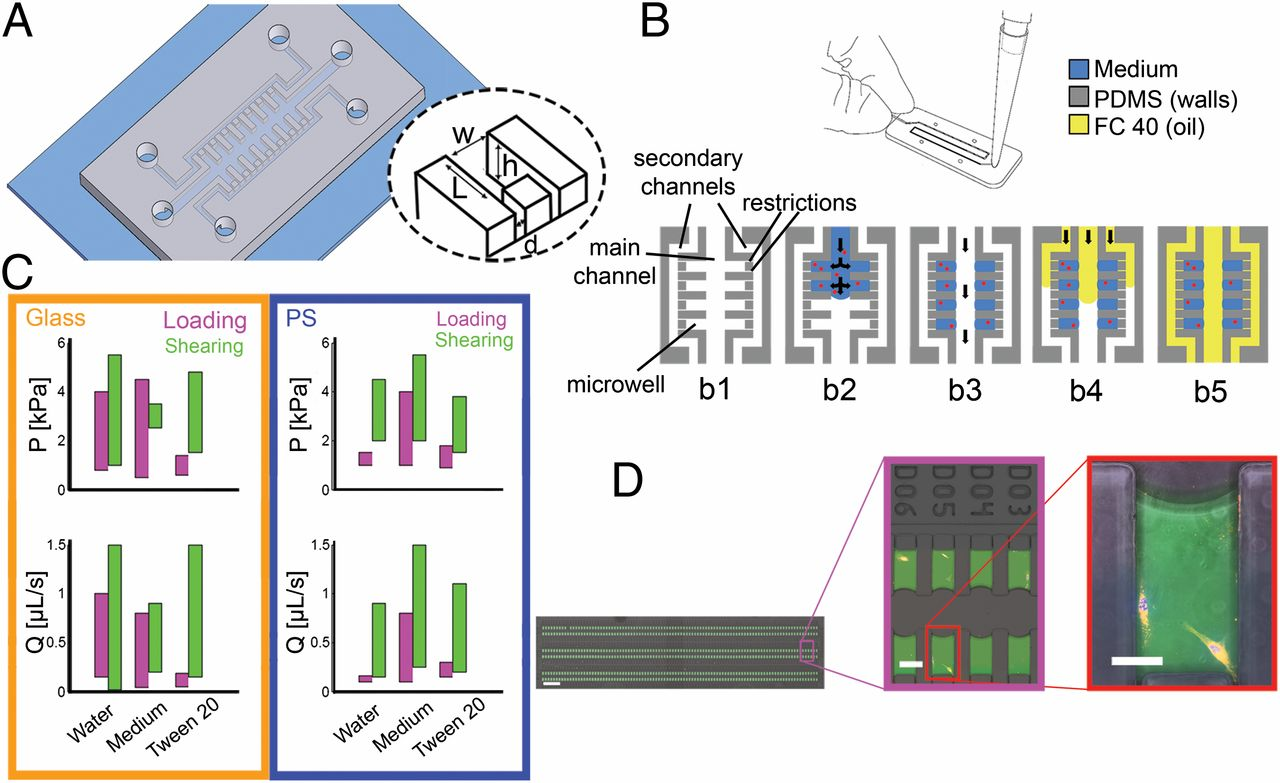PNAS:长期分析大量单细胞的新装置

目前,一种便携式、廉价的微流体装置,可让研究人员长期、同时监测大量的单细胞。在很长的时间尺度上测量细胞过程,这将会如何改善相关研究和诊断呢?
一种简单的新方法,通过将细胞隔离在微流体装置中的单独纳升液滴中,可让研究人员能够对数百个细胞同时进行长期分析。这种方法发表在最近的《PNAS》杂志,能够使粘附和非粘附细胞支持在组织培养板和盖玻片上,不需要外部设备或机械,因此,这种方法非常适合于床旁检测使用。
本文资深作者、以色列科学技术研究所的Shulamit Levenberg称:“我们非常惊讶地看到,我们能够监测单个细胞的行为,如代谢和生长。该装置可以用于各种细胞诊断应用,尤其是罕见的细胞或病原体。”
在微流体装置内,有一系列的nanowells,从一个连接到次要通道的主通道分支出来。研究人员将含有细胞的溶液注入主要通道,然后应用气压来产生单独液滴。注入主要通道和次要通道的油,可用化学方法隔离出液滴。
利用这种方法,Levenberg和她的研究小组培养了单个粘附人皮肤细胞和非粘附小鼠白血病细胞,以及大肠杆菌(Escherichia coli)和金黄色酿脓葡萄球菌(Staphylococcus aureus)细胞,并证明这些细胞能够在几小时到几天之内进行增殖。他们还使用这种装置,连续地监测单个粘附细胞的代谢活性,并确定血液来源的样本中可育病原体的浓度。
研究人员还产生了一个沿数百个液滴的化学梯度,同时控制每个液滴的最小和最大溶液浓度以及液滴之间的化学梯度坡度。这种梯度与小型化高通量筛选实验相关,例如检测生长因子浓度对细胞的影响,或者抗生素对细菌的影响。
根据作者介绍,这种方法对于依赖长期测量细胞过程的研究和诊断应用,都很具有实用性。在未来,可以用它来研究免疫细胞之间的交流,以及单细胞对整个细胞群体反应的贡献。此外,它仅需要几微升试剂,允许细胞重新取回用于标准的细胞培养技术。因为它是非常廉价和便携式的技术,不需要传统液滴微流体的复杂仪器,所以应该可以广泛用于实验室和条件恶劣的环境。
原文摘要:
Stationary nanoliter droplet array with a substrate of choice for single adherent/nonadherent Cell incubation and analysis
Abstract: Microfluidic water-in-oil droplets that serve as separate, chemically isolated compartments can be applied for single-cell analysis; however, to investigate encapsulated cells effectively over prolonged time periods, an array of droplets must remain stationary on a versatile substrate for optimal cell compatibility. We present here a platform of unique geometry and substrate versatility that generates a stationary nanodroplet array by using wells branching off a main microfluidic channel. These droplets are confined by multiple sides of a nanowell and are in direct contact with a biocompatible substrate of choice. The device is operated by a unique and reversed loading procedure that eliminates the need for fine pressure control or external tubing. Fluorocarbon oil isolates the droplets and provides soluble oxygen for the cells. By using this approach, the metabolic activity of single adherent cells was monitored continuously over time, and the concentration of viable pathogens in blood-derived samples was determined directly by measuring the number of colony-formed droplets. The method is simple to operate, requires a few microliters of reagent volume, is portable, is reusable, and allows for cell retrieval. This technology may be particularly useful for multiplexed assays for which prolonged and simultaneous visual inspection of many isolated single adherent or nonadherent cells is required.
作者:网络

